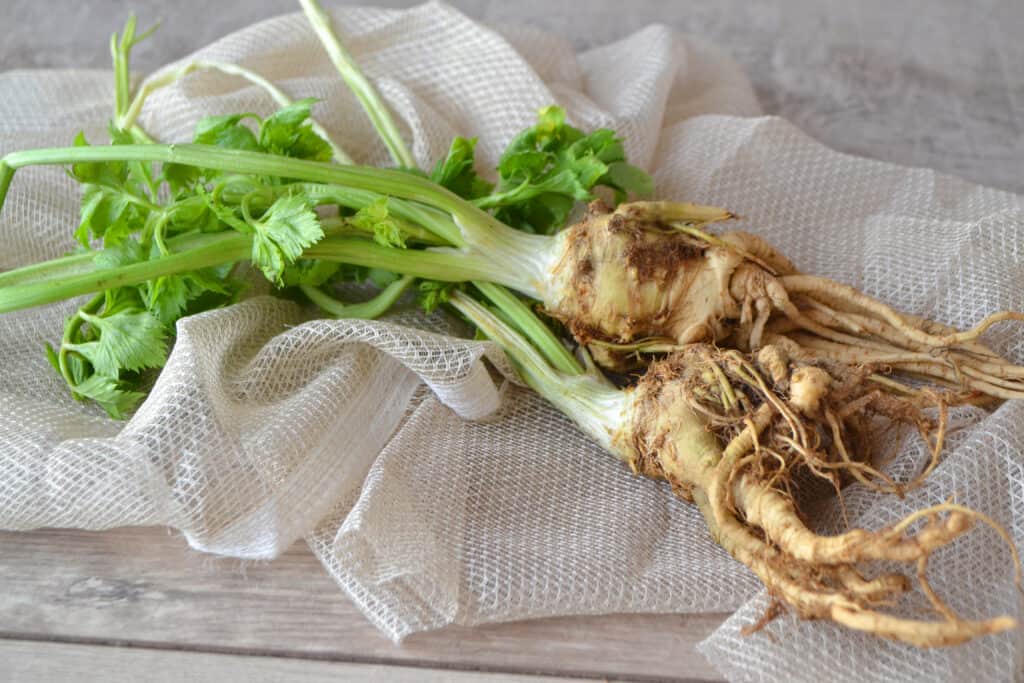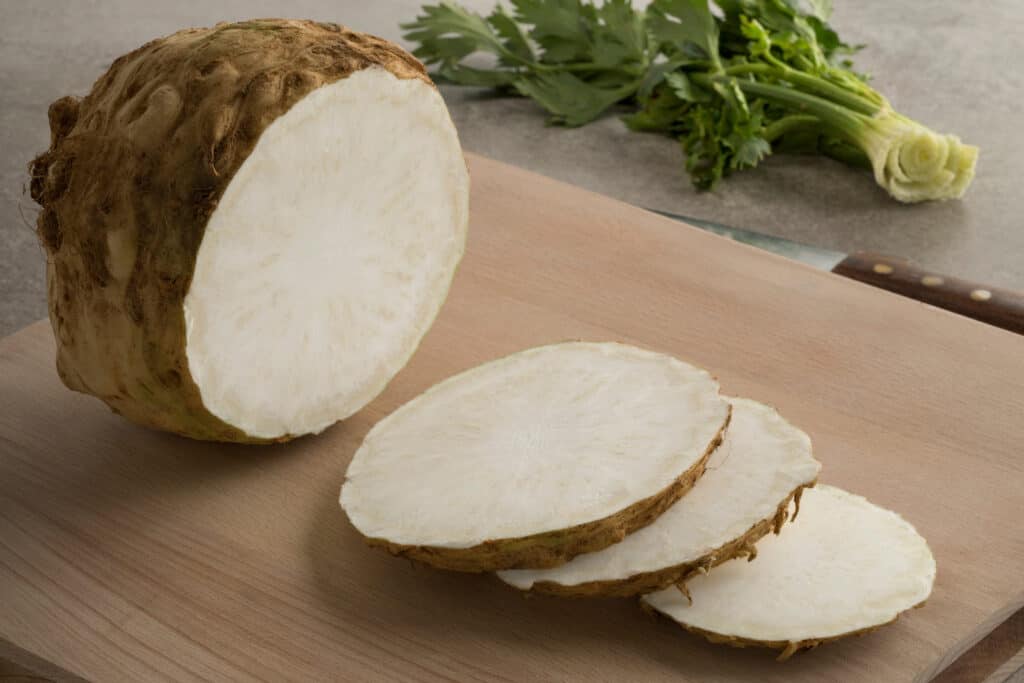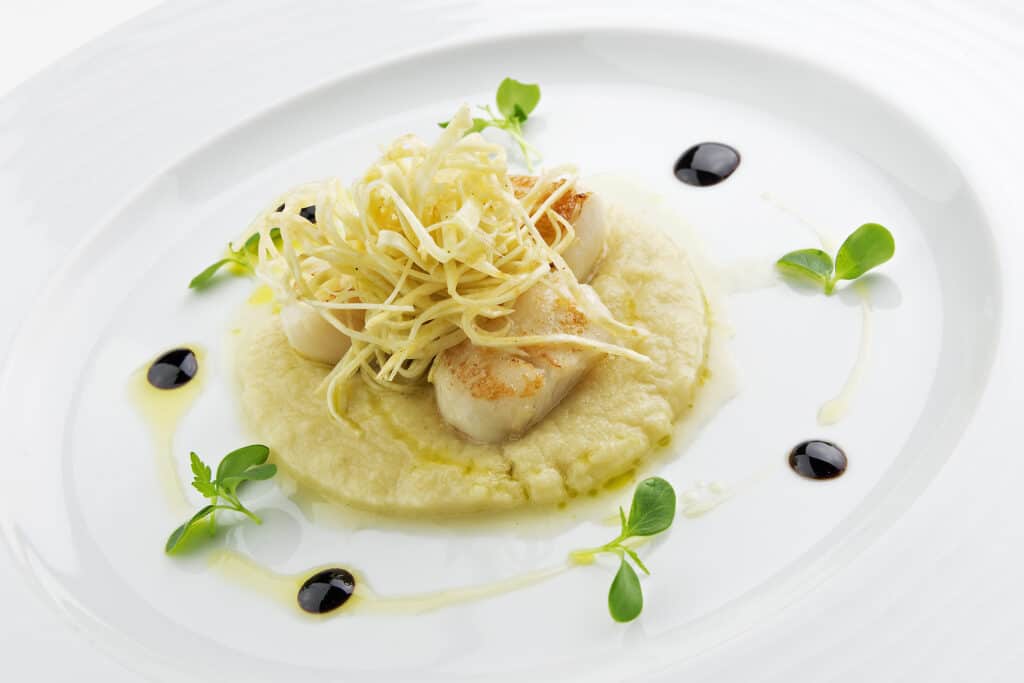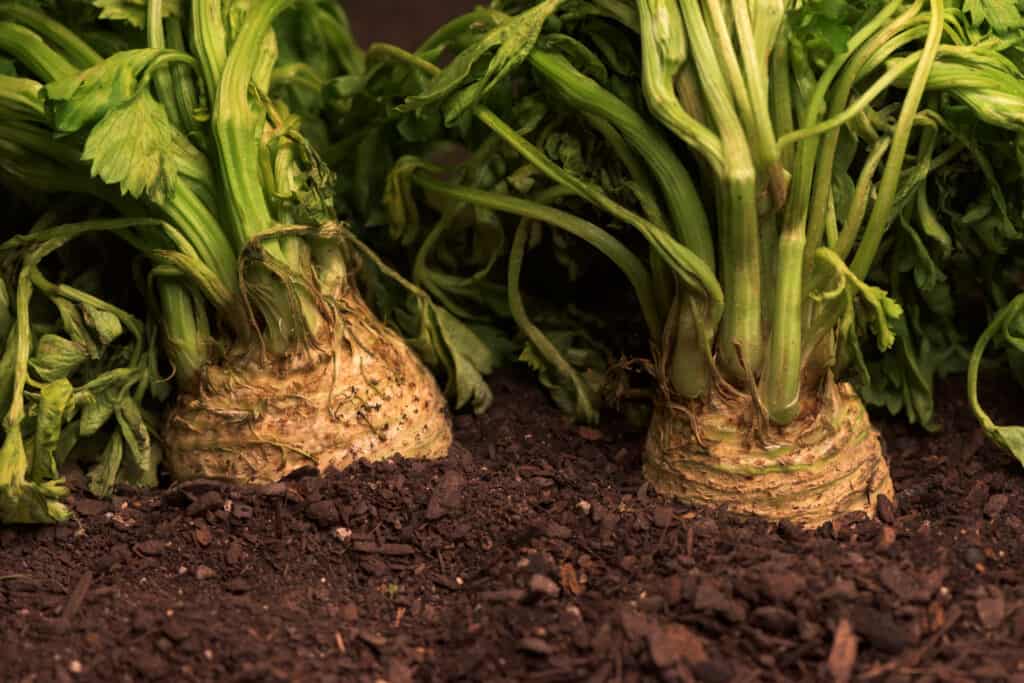Celeriac can be served cooked or raw. Celeriac combines the sweet taste of the mildest celery with the light peppery zip of parsley.
Celeriac—which is also known as celery root, celery knobs, and turnip-rooted celery—is a cool-weather vegetable that comes to harvest between late fall and early spring.

How to choose celeriac
- Select large, smooth celery knobs with a minimum of rootlets. If the leaf tops are attached they should be green and crisp (but the leaves are not edible).
- Avoid small or soft celeriac or celeriac that sounds hollow.
- Because celeriac is so thick-skinned and must be peeled before it is served, there may not be much flesh to enjoy if you choose a root that is too small.
- Look for roots that are more than 3 inches (7.5 cm) in diameter.
Kitchen Helpers from Amazon:
- Oster Vegetable Steamer
- Chef’s Knives Set of 6
- EZ Off Jar Opener for Weak Hands
- Pepper Core Remover Stainless Steel
- Kitchen Utensils – Set of 35
How to store celeriac
- Celeriac will keep in the refrigerator for up to one week in a perforated bag.
- Celeriac can also remain in the ground in areas where freezing weather is not a problem.
- Celeriac does not freeze well.

How to prep celeriac
- Before using celeriac, wash and then cut off the top and a thin slice of the base.
- Celeriac is often covered with little roots; these should be cut away.
- Unless otherwise directed in a recipe, do not peel; the root will darken if cooked unpeeled.
- After cooking peel away the outer skin with a knife.
- Once peeled, drop the bulb into cold acidulated water to prevent the bare root from discoloring.
- Cook whole or cut-up celeriac in water with lemon juice until tender to the core when pierced.
How to boil celeriac
- Cover and cook the whole root in boiling salted water until just tender, about 30 to 40 minutes.
- Drain then peel the root.
- Cut into slices and serve melted butter, salt, and pepper to taste.
How to broil celeriac
- Boil and slice as directed above.
- Arrange the slices in a buttered baking dish, dot with butter, and sprinkle with grated Parmesan and Gruyere cheese
- Place under the broiler and cook until the cheese melts and lightly browns.
How to bake celeriac
- Preheat the oven to 350 degrees F.
- Thinly slice raw celeriac and potatoes.
- Arrange the slices in layers and dot them with butter.
- Barely cover the slices with beef or chicken stock.
- Bake until tender, about 45 minutes.

How to sauté celeriac
- Boil the root as directed above.
- Slice the cooked and drained celeriac.
- Melt butter in a skillet and add the sliced celeriac; add salt and freshly ground pepper to taste.
- Saute for 4 minutes, turning often
- Transfer to a heated serving dish and sprinkle with chopped chives or chopped parsley.

How to make celeriac and potato gratin
- Preheat the oven to 350 degrees F.
- Butter a covered 9 x 12-inch baking dish.
- Lay a layer of sliced celeriac on the bottom and top with butter and a dash of salt.
- Add a layer of thinly sliced potatoes.
- Alternate layers and end with a top layer of potatoes.
- Dot the top layer with butter and add a cup or slightly more broth or bouillon or heavy cream.
- Cover the dish and bake until the potatoes and celeriac are tender about 45 minutes.
- When the potatoes and celeriac are tender, sprinkle the top with grated cheese and return to the oven and cook uncovered for another 10 to 15 minutes

Celeriac serving suggestions
- Celeriac can be served raw or cooked.
- Grate or shred to use in salads: dress with a vinaigrette.
- Cut into thin strips or cubes and serve as a salad seasoned with rémoulade dressing.
- Cook alone or with other vegetables: allow 10 to 15 minutes when boiling and 12 to 18 minutes when steaming.
- Peel, dice, and boil, then marinate in vinegar and oil.
- Use raw as a flavoring in salads, soups, and stews.
- Top with Mornay and béchamel sauce and grantinéed.
- Mash 2 parts cooked potatoes with 1 part cooked celeriac.
- Celeriac can is sometimes used as a substitute for potatoes.
- Celeriac goes well with apples, cream, game birds, mayonnaise, mustard, potatoes, roast beef, veal, chicken, and truffles.
- Celery root rémoulade is a standard first course or hors d’oeuvre in cafes in France. With rémoulade—a mayonnaise-based sauce, celeriac is sliced into fine julienne strips and served uncooked.
- But celery root also can be boiled, braised, sautéed, and baked. Diced and boiled it will be ready in about ten minutes.
- In Romania, a favorite cooked celeriac salad includes chopped ham, oil, vinegar and parsley, and a sour pickle and black olive garnish.
- Celery root also can be served in purées, soups, fritters, and stuffings.
Celeriac nutrition
- Celeriac contains a small amount of vitamins B and C, and is rich in calcium and phosphorus, and iron.
- A medium serving of celeriac contains a total of 38 calories.

Get to know celeriac
- Celeriac is a turnip-like, bumpy-knob of a root that forms just above the ground. It grows from 2 to 6 inches (5-15 cm) in diameter and has a rough brownish skin that is dotted with rootlets. Underneath its thick skin, celeriac has a creamy white, crisp flesh.
- Celeriac is not the same plant as stalk celery. It is a variety of celery that has been cultivated for its bulbous root, not its stalks.
- While both celery and celeriac got their start in the ancient marshlands of the Mediterranean region, celeriac was adapted for cooler weather. It was cultivated by the ancient Greeks and Romans and later considered a delicacy in the Arab world.
- Today celeriac is commonly grown in northern and Eastern Europe where stalk celery does not grow well. To a lesser extent, it is also grown in Asia and North America.
The botanical name for celeriac is Apium graveolens var. rapaceum.
Celeriac at Harvest to Table:
How to Plant, Grow, and Harvest Celeriac
Five Ways to Cook and Serve Celeriac
How to Harvest and Store Celery
Tasty Ways to Cook and Serve Celery
Celery Growing Problems Troubleshooting
Articles of interest:
Best Herbs for Container Growing
Garden Planning Books at Amazon:
- Vegetable Garden Almanac & Planner
- Kitchen Garden Grower’s Guide Vegetable Encyclopedia
- Vegetable Garden Grower’s Guide
- Tomato Grower’s Answer Book
More kitchen tips:
Bring your harvest to the table. Kitchen prep tips and easy recipes for the vegetables you grow. Click below for vegetable prep and recipes you can use now.
- Almonds
- Apples
- Apricot
- Aprium
- Artichoke
- Arugula
- Asparagus
- Avocado
- Bamboo Shoots
- Banana
- Basil
- Beans, Dried
- Beans. Long
- Beans, Shell
- Beans, Snap
- Beets
- Bitter Melon
- Blackberry
- Bok Choy
- Broccoli
- Broccoli Raab
- Brussels Sprouts
- Cabbage
- Cardoon
- Carrots
- Cauliflower
- Celeriac
- Celery
- Chard
- Chayote Squash
- Cherimoya
- Cherries
- Chestnut
- Chickpea
- Chinese Cabbage
- Chives
- Cilantro
- Citron
- Clementine
- Collards
- Coriander
- Corn, Sweet
- Corn, Baby
- Corn Salad, Mache
- Cranberry
- Cress
- Cucumber
- Daikon
- Dandelion
- Dill
- Eggplant
- Endive, Belgian
- Endive and Escarole
- Fava Beans
- Fig
- Florence Fennel
- Garlic
- Ginger
- Grapefruit
- Grapes
- Guava
- Horseradish
- Jerusalem Artichoke
- Jicama
- Jujube
- Kale
- Kiwifruit
- Kohlrabi
- Kumquat
- Leeks
- Lemongrass
- Lemons
- Lettuce
- Lime
- Mache (Corn Salad)
- Mandarin Orange
- Mango
- Maple Syrup
- Marjoram
- Melons
- Michihili
- Mint
- Mizuna
- Mushrooms
- Mushrooms, Cremini
- Mustard Greens
- Napa Cabbage
- Nectarine
- Okra
- Olives
- Olive oil
- Onions
- Oranges
- Oregano
- Parsley
- Parsley Root
- Parsnips
- Passion Fruit
- Pawpaw
- Peaches
- Pears
- Peas, Garden Snap
- Peas, Snow
- Pei Tsai
- Peppers, Chili
- Peppers, Sweet
- Persimmon
- Pineapple
- Pineapple Guava
- Plantain
- Plums
- Pluots
- Pomegranate
- Potatoes
- Prickly Pear
- Pumpkin
- Quince
- Radicchio
- Radishes
- Raspberries
- Rosemary
- Rhubarb
- Rutabaga
- Sage
- Salsify
- Sauerkraut
- Savory
- Shallots
- Sorrel
- Spinach
- Squash, Summer
- Squash, Winter
- Strawberries
- Sunchokes
- Sunflower
- Sweet Potato
- Swiss Chard
- Tangerine
- Taro
- Tarragon
- Thyme
- Tomatillo
- Tomato
- Turnip
- Turnip Greens
- Yams















